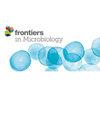Effects of supplemental feeding of Chinese herbal mixtures to perinatal sows on antioxidant capacity and gut microbiota of sows and their offspring piglets
IF 4
2区 生物学
Q2 MICROBIOLOGY
引用次数: 0
Abstract
The stress response of pig herds poses a significant challenge in the pig breeding industry, and investigating strategies to mitigate this stress is of paramount importance. The objective of this study was to investigate the impacts of supplemental feeding of Chinese herbal mixtures to perinatal sows on antioxidant capacity and gut microbiota of sows and their offspring piglets. A total of 60 healthy sows (Large white) at fourth parity were randomly assigned to five treatment groups. The control group received a basal diet, while the TRT1 group received a basal diet supplemented with 2kg/t Bazhen powder (BZP). The TRT2, TRT3, and TRT4 groups were fed a basal diet supplemented with 1kg/t, 2kg/t, and 3kg/t Qi-Zhu- Gui-Shao soothing liver and replenishing blood powder (QZGSP), respectively. The trial lasted for 5weeks, starting from day 100 of gestation until day 21 of delivery. The results demonstrated that the inclusion of 2kg/t and 3kg/t QZGSP significantly enhanced the antioxidant capacity of sows and their offspring piglets to different degrees, thereby effectively alleviating oxidative stress. Analysis of gut microbiota revealed that QZGSP influenced the composition of gut microbiota in both sows and their offspring piglets. Specifically, at the genus level, the abundance of围产期母猪补饲中草药混合物对母猪及其后代仔猪抗氧化能力和肠道微生物群的影响
猪群的应激反应是养猪业面临的一项重大挑战,因此研究缓解这种应激反应的策略至关重要。本研究旨在探讨围产期母猪补饲中草药混合物对母猪及其后代仔猪抗氧化能力和肠道微生物群的影响。将 60 头健康的四胎母猪(大白)随机分配到五个处理组。对照组饲喂基础日粮,TRT1 组饲喂添加 2 千克/吨八珍粉(BZP)的基础日粮。TRT2组、TRT3组和TRT4组分别在基础日粮中添加1千克/吨、2千克/吨和3千克/吨的杞竹桂芍舒肝补血散(QZGSP)。试验持续了 5 周,从妊娠第 100 天开始到分娩第 21 天结束。结果表明,添加 2kg/t 和 3kg/t QZGSP 能在不同程度上显著提高母猪及其后代仔猪的抗氧化能力,从而有效缓解氧化应激。肠道微生物群分析表明,QZGSP 对母猪及其后代仔猪的肠道微生物群组成均有影响。具体来说,在菌属水平上,TRT4组母猪肠道微生物群中Christensenellaceae_R-7_group的丰度显著低于TRT1组(p&;lt;0.05),而TRT4组母猪肠道微生物群中乳酸杆菌的相对丰度显著高于CON组(p&;lt;0.05)。此外,在菌属水平上,与 TRT1 组相比,TRT4 组仔猪肠道微生物群中的石灰样肠杆菌(Escherichia-Shigella)、副乳杆菌(Parabacteroides)和甲烷杆菌(Methanobrevivacter)的相对丰度显著下降(pamp &;lt;0.05),但法氏囊杆菌(Phascolarctobacterium)的相对丰度显著上升(pamp &;lt;0.05)。斯皮尔曼相关分析表明,Christensenellaceae_R-7_group 的相对丰度与血清中 T-AOC 和 CAT 的含量呈正相关(p&;lt; 0.05),与血清中 MDA 的浓度呈负相关(p&;lt; 0.05)。此外,乳酸菌的相对丰度与血清中 SOD(p&p;lt; 0.01)和 GSH-Px (p&p;lt; 0.05)的含量呈正相关。因此,在围产期母猪日粮中添加 3 千克/吨的 QZGSP 可显著提高母猪和后代仔猪的抗氧化能力,同时调节其肠道微生物区系的组成和结构。这项研究结果表明,QZGSP 是一种对围产期母猪有益的饲料添加剂。
本文章由计算机程序翻译,如有差异,请以英文原文为准。
求助全文
约1分钟内获得全文
求助全文
来源期刊

Frontiers in Microbiology
MICROBIOLOGY-
CiteScore
7.70
自引率
9.60%
发文量
4837
审稿时长
14 weeks
期刊介绍:
Frontiers in Microbiology is a leading journal in its field, publishing rigorously peer-reviewed research across the entire spectrum of microbiology. Field Chief Editor Martin G. Klotz at Washington State University is supported by an outstanding Editorial Board of international researchers. This multidisciplinary open-access journal is at the forefront of disseminating and communicating scientific knowledge and impactful discoveries to researchers, academics, clinicians and the public worldwide.
 求助内容:
求助内容: 应助结果提醒方式:
应助结果提醒方式:


